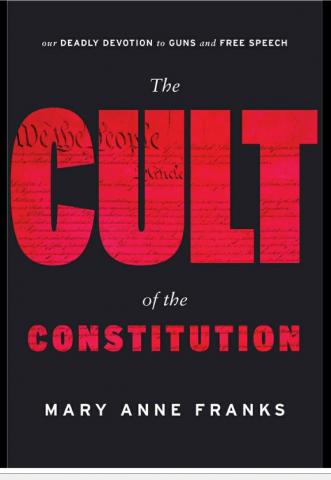Review of Cult of the Constitution by Mary Anne Franks

When it first came out, I missed Mary Anne Franks’ book, The Cult of the Constitution: (Stanford University Press, 2019). But I just finished reading it, and I recommend it as a very provocative discussion of the U.S. Constitution. Franks observed: “We are facing a continuing crisis of constitutional inequality. For more than two hundred years, the lion’s share of legislative, judicial, political, and social resources has been devoted to protecting the constitutional rights of white men above all others…It is hardly surprising, then, that the picture of who holds power today does not look that different from 1787.” (pgs. 34 & 30)
Franks discusses the cult of free speech as promoted by organizations like the ACLU and the cult of guns as promoted by the NRA. From opposite directions, these cults are adopting what she calls constitutional fundamentalists. According to Franks, both sides interpret the Constitution in ways that serve the interests of white men. The internet introduced another form of constitutional fundamentalism. These fundamentalists claim that the internet is protected by the Constitution from control by the government. So, laws and the courts are unable to protect the interests of women and nonwhite men.
By the end of the 4th chapter Franks has made a persuasive argument that the Constitution is designed to and continues to protect the interests of white men. However, I am uncomfortable with her concluding chapter. Franks immediately shows her hand. She wants “to remain faithful to the Constitution.” (pg. 231) At the same time, she wants to end white men’s monopoly on power.
After describing white abolitionist William Lloyd Garrison’s condemnation of the Constitution because it preserved white privilege, she notes that some modern scholars have proposed re-writing the Constitution to address its flaws. She admits, “If constitutional reverence prevents us from achieving the values essential to a just and democratic society, then we should terminate our sentimental attachment to the document.” (pg. 232) So, the question we must ask is, “Does her proposed solution create a just and democratic society?” Is Franks’ sentimental attachment to the Constitution, her commitment to remain faithful to the Constitution, justified?
|
All persons born or naturalized in the United States, and subject to the jurisdiction thereof, are citizens of the United States and of the State wherein they reside. No State shall make or enforce any law which shall abridge the privileges or immunities of citizens of the United States; nor shall any State deprive any person of life, liberty, or property, without due process of law; nor deny to any person within its jurisdiction the equal protection of the laws. Constitution of the U.S.A., Amendment 14, Section 1 |
In short, her answer is that Article V of the Constitution provides for a method to add amendments. So, “Those who came after the founders had enough wisdom to ‘reconstruct’ the Constitution after the Civil War, attempting to reckon, belatedly, with America’s original sin.” (p. 232)
It is a small point, but I doubt that the white men who wrote and passed the three Civil War amendments were attempting to address racism or white men supremacy. Instead, their motivation was to make sure that each former slave was counted as a full person and that the males could vote. It was important to them to get this set in the Constitution before the southern states were returned to the Union because they reasoned the white southerners might object. And the northern white men thought that with the former slaves voting, the Republican party of Lincoln would always control American politics.
Franks’ point is not about the history of the 14th amendment, though. She proposes that people who are constitutional fundamentalists should be convinced that rather than focusing on the 1st and 2nd amendments, they should agree that the 14th amendment is the guiding light for all legislation. She explains, “It is a rule as well as a right, a test that must be universally applied to all laws, including other constitutional rights. The Fourteenth Amendment tells us that if white men’s rights to free speech or self-defense are protected more than women and nonwhite men’s, the Constitution has been violated. If white men’s rights to free speech or self-defense infringe upon those same rights of women or nonwhite men, the Constitution has been violated. Because of the Fourteenth Amendment, one can only honor the Constitution by honoring equality.” (pp. 233-234).
The circle is closed. For those like Franks who are committed to “remain faithful” to the Constitution, honoring the Constitution requires taking the 14th amendment seriously. One question that Franks does not address is whether honoring the Constitution is sufficient to address the many flaws in the Constitution which support and preserve white male supremacy. Can laws based on the 14th amendment change the structure of power that the first four chapters of her book outline?
The electoral college is a good case to consider because the Constitution establishes the process by which electors are selected. In 2016 a woman won 2% more votes than the man she ran against, but a man became President. Constitutional structure resulted in putting a white man into the presidency who did not win the popular vote. Admittedly the 14th amendment is only addressed to the responsibilities of states and does not say that the federal government must ensure “equal protection of the laws,” but only re-writing the Constitution can fix this structural design that privileges white men.
This is a case where some people with very good intentions are attempting to solve a problem with the Constitution without changing it. They are working to have states pass laws so that all of their electoral college votes will go to the candidate who wins the largest number of popular votes in the whole nation. This would ensure that the most popular person becomes President, but there is a possibility with the existing Constitution that the Supreme Court would not allow the process. And at any time, state legislatures could decide to pull out of the pact and change the outcome of an election.
Other flaws in the Constitution that preserve and protect the dominance of white men do not have possible state laws to work around the problem. The makeup of the Senate is a good example of this. Individuals living in states with large populations do not have equal representation in the Senate with people who live in states with small populations. State laws cannot solve this constitutional problem.
Given Franks’ commitment to solving the problem that “white men have enjoyed more than two centuries of constitutional affirmative action; their rights are not only secure but dominant,” why is she opposed to changing the Constitution to address this problem? Franks offers three reasons for not re-writing the Constitution.
First, she claims that “the Constitution is, for now, the nation’s binding document, and it is unlikely that it will be set on fire, or even significantly amended, any time soon.” (p. 232) This is saying to women and nonwhite men, “We are sorry, but the white men have such a strong hold on power in America that it will be impossible to end white men’s control. No matter what you do to change the structures of power, you will fail. So don’t even think about equal participation or taking away the monopoly on power of white men. All you can hope for is to gain “equal protection of the laws” that white men make.
Second, Franks says, “Constitutional claims will probably always retain powerful rhetorical appeal, and those who criticize the Constitution will probably always be attacked as unpatriotic, perhaps even treasonous.” (p. 232) This is an interesting reason for discouraging people from working to fix the Constitution. The authors of the Constitution had just participated in a War of Independence. They were traitors in the eyes of the British King and Parliament. As late as 1812 the British tested the legitimacy of their treasonous act of establishing an independent government. It is not patriotic to be blindly loyal to a document that as Franks demonstrates in her first four chapters is designed to deny full civil and human rights to all Americans. If the American founders had feared being called traitors, we would not have a constitution.
Third, Franks admins that the Constitution is flawed. She demonstrated this in the first four chapters. But she says it is more compelling to claim “this is what the Constitution means” (p. 232) than to claim that the Constitution is flawed. This argument would make more sense if she had already demonstrated that a commitment to the 14th amendment will solve all of the problems created by the structure of the Constitution. This is like telling someone to take a particular road because it is easier even though it does not lead to where the person wants to go.
Although Franks does not make the argument explicitly, her proposal is based on another commonly held argument. She says, “The Fourteenth Amendment thus commits the constitutional faithful to a position incompatible with supremacy or hierarchy of any kind. Like the Golden Rule and Immanuel Kant’s categorical imperative, the equal protection imperative provides us with the means of distinguishing prejudice from principle. The Golden Rule states that we must treat others as we would wish to be treated; in Kantian terms, “It is always wrong to act in one way while wishing that everyone else would act otherwise.” (p. 233)
In its simplest form this is the claim that if we will all learn to treat each other with respect and kindness then white men will give up their desire to retain power. Actually, one of the arguments that white men make is that they have worked hard, followed the rules, and earned their positions of power. They argue that if others followed their example, there would be equality. These same white men claim that the current system treats everyone the same way they want to be treated. They are rewarded for their hard work. The ideology that supports white men’s conviction to retain their power is, in their minds, consistent with the Golden Rule and the Kantian imperative.
Creating a multicultural nation without racism requires removing the monopoly on power that white men organized at the founding of American. White men have successfully preserved their monopoly to this day because of the organized structure of power established by the Constitution. Breaking this monopoly requires political action. At the end of the last chapter Franks says, “to achieve the unfinished project of equality, we must reorient our constitutional attention to those whose rights have been excluded, ignored, and subordinated.” (p. 235) Let’s stop telling ourselves that it is impossible to change the Constitution. Let’s stop telling ourselves that working to end the white man’s monopoly is traitorous. Let’s stop telling ourselves that working for equal protection under the laws that white men make is the same as creating a future America where all identity groups have equal participation. Let’s start the conversation about how to fix the Constitution.
All references are to Franks, Mary Anne. The Cult of the Constitution. Stanford University Press. Kindle Edition. 2019.




 Contact Us
Contact Us